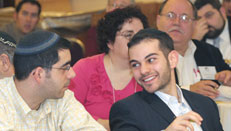 |
||||||||||||
| Weekly Parsha | ||
| Current Week | ||
| Parsha Archives | ||
| Business Ethics | ||
| Dr. Malamet Speaks Out | ||
| TiM MP3 Library | ||




A Thought for the Week with Rabbi Jay Kelman
|
 One of the key ways by which groups self-identify is through the medium of clothes. Almost all religions have some form of dress code and uniforms, which aim to foster a sense of uniformity in action and sometimes in thought, are the norm among such diverse groups as the police force, athletes, fast-food workers and airlines. The more casual business attire now widely accepted reflects the desire for individuality in the workplace, as society becomes much more attuned to quality of life issues. As styles of clothing reflect the cultural mores of the time, it is to be expected that, often, the first sign of rebellion against the accepted norms of one's environment is through a change of dress. Yet it should be obvious that clothing is no more than an external garment and does not necessarily reflect the essence of the person. "These are the vestments that they shall make; a breastplate, an ephod (vest), a robe, a knitted tunic, a turban and a sash" (28:4). The Torah is quite insistent that those who worked in the Temple be appropriately dressed. Failure to do so made one liable to "death at the hands of heaven". Clothes originated in the aftermath of the sin of man's disobedience to G-d in Gan Eden. As a consequence of using our physical body for sin, we were instructed to cover much of it with clothes. If clothes are the outgrowth of sin, they must also serve as a vehicle for teshuva, a return to man's original state of purity. Our Sages saw each of the eight garments that adorned the high priest as facilitating atonement for particular sins (Erchin 16a). For example, the tzitz, the plate of gold the Kohen Gadol attached to his turban, atoned for the sin of arrogance. The Kohen was enjoined from raising his hands above the tzitz constantly reminding us that all are subservient to G-d. The michnasaim, pants, worn by the Kohen Gadol atoned for sins of sexual immorality. Coming to the Temple and reflecting on the elegant clothes of the priests was a means to moral improvement. The first piece of clothing mentioned is that of the choshen, the breastplate, worn by the high priest. Our Sages state that the choshen had the ability to atone for the sins of miscarriage of justice; it is referred to in the Biblical text as the choshen hamishpat, the breastplate of justice. The path to G-d begins with ensuring monetary justice for all. Contained within the breastplate were the Urim vTumim, literally the lights and perfection, whereby G-d "communicated" to the high priest regarding issues of national importance. In other words, G-d's relationship to the people of Israel is predicated upon our monetary integrity. Not by chance did Rav Yosef Karo-author of the standard code of Jewish law, the Shulchan Aruch -codify the vast corpus of monetary law in the section entitled Choshen Mishpat . Many of the commentaries on the Shulchan Aruch took their titles from the description of the choshen hamishpat ; classic rabbinic works such as the Ktoz Hachoshen , the Avnei Milueem and the Urim Vtumim . The centerpiece of the choshen hamishpat is the four rows of stone, the arba turim ; this is also the name of the code on which Rav Yosef Karo based his Shulchan Aruch. The Torah makes mention of the choshen hamishpat even before it describes the ephod that served as an atonement for idolatry, specifically for the sin of the golden calf. G-d can and does forgive idolatry but He is much less forgiving when one takes monetary advantage of another. G-d is effectively "unable" to forgive sins inflicted upon our fellow man, a notion reflected in the fact that our teshuva on Yom Kippur is meaningless if we continue to sin against our fellow man. Clothes may reflect our values and beliefs, but they are only a means to an end. In order to ensure that our clothes are "for splendour and beauty", we must see beyond the clothes in order to come closer to G-d and our fellow man. |
|
|

 |
 |